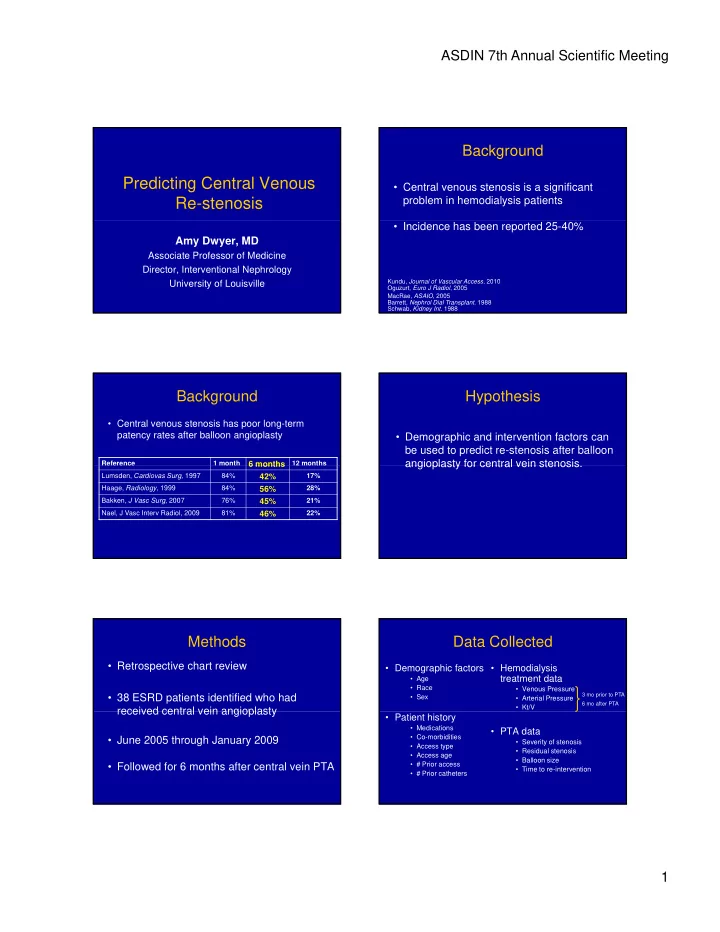

ASDIN 7th Annual Scientific Meeting Background Predicting Central Venous • Central venous stenosis is a significant Re-stenosis problem in hemodialysis patients • Incidence has been reported 25-40% Amy Dwyer, MD Associate Professor of Medicine Director, Interventional Nephrology Kundu, Journal of Vascular Access , 2010 University of Louisville Oguzurt, Euro J Radiol , 2005 MacRae, ASAIO , 2005 Barrett, Nephrol Dial Transplant . 1988 Schwab, Kidney Int . 1988 Background Hypothesis • Central venous stenosis has poor long-term patency rates after balloon angioplasty • Demographic and intervention factors can be used to predict re-stenosis after balloon angioplasty for central vein stenosis angioplasty for central vein stenosis. Reference 1 month 6 months 6 months 12 months Lumsden, Cardiovas Surg, 1997 84% 17% 42% Haage, Radiology , 1999 84% 56% 28% Bakken, J Vasc Surg , 2007 76% 21% 45% Nael, J Vasc Interv Radiol, 2009 81% 46% 22% Methods Data Collected • Retrospective chart review • Demographic factors • Hemodialysis treatment data • Age • Race • Venous Pressure 3 mo prior to PTA • 38 ESRD patients identified who had • Sex • Arterial Pressure 6 mo after PTA • Kt/V received central vein angioplasty received central vein angioplasty • Patient history • Medications • PTA data • Co-morbidities • June 2005 through January 2009 • Severity of stenosis • Access type • Residual stenosis • Access age • Balloon size • Followed for 6 months after central vein PTA • # Prior access • Time to re-intervention • # Prior catheters 1
ASDIN 7th Annual Scientific Meeting Patient Demographic Data Statistical Analysis Characteristic No Re-stenosis Re-stenosis N= 29, (%) N= 9, (%) Sex Male 10 (34.4) Male 6 (66.6) Age (years) 55.1 54.2 • Prediction of re-stenosis was evaluated by AA 25 (86.2) AA 7 (77.7) Race Caucasian 2 (6.9) Caucasian 2 (22.2) cox-proportional hazards analysis. Hispanic 1 (3.4) Hispanic 0 Arteriovenous fistula Arteriovenous fistula 26 (89 6) 26 (89.6) 5 (55.5) 5 (55 5) DM 11 (37.9) 6 (66.6) HTN 26 (89.6) 9 (100) Peripheral vascular disease 2 (6.9) 1 (11.1) Congestive heart failure 7 (24.1) 1 (11.1) Coronary artery disease 5 (17.2) 2 (22.2) Cerebral vascular event 1 (3.4) 1 (11.1) 7 (24.1) 3 (33.3) Aspirin Clopidogrel 1 (3.4) 0 Wafarin 3 (10.3) 2 (22.2) Results Results Table 2. Covariates used in analysis of re-stenosis rate Table 2. Covariates used in analysis of re-stenosis rate Variable No Re-stenosis Re-stenosis Variable No Re-stenosis Re-stenosis (N = 29) (N = 9) (N = 29) (N = 9) Hemoglobin (gm/dl) Hemoglobin (gm/dl) 11.0 12.1 11.0 12.1 3 months prior to PTA 3 months prior to PTA 11.5 12.2 11.5 12.2 6 months after PTA 6 months after PTA Venous Pressure (mm Hg) Venous Pressure (mm Hg) 216.0 216 0 247.9 247 9 216 0 216.0 247 9 247.9 3 months prior to PTA 3 th i t PTA 3 3 months prior to PTA th i t PTA 224.6 243.9 224.6 243.9 at time of PTA at time of PTA 234.6 226.3 234.6 226.3 6 months after PTA 6 months after PTA Arterial Pressure (mm Hg) Arterial Pressure (mm Hg) -173.3 -192.2 -173.3 -192.2 3 months prior to PTA 3 months prior to PTA -193.7 -203.1 -193.7 -203.1 at time of PTA at time of PTA -220.3 -189.7 -220.3 -189.7 6 months after PTA 6 months after PTA kt/v kt/v 1.57 1.61 1.57 1.61 3 months prior to PTA 3 months prior to PTA 1.64 1.60 1.64 1.60 at time of PTA at time of PTA 1.60 1.63 1.60 1.63 6 months after PTA 6 months after PTA Results • Average difference in venous pressure 3 months prior to the initial intervention • 216 mmHg in the no re-stenosis group 216 mmHg in the no re stenosis group • 248 mmHg in the re-stenosis group (p=0.041) Figure 1. Kaplan- Meier plot of venous pressure plotted as two groups divided at the mean pressure for all subject. Subjects with a mean venous pressure less than 223 mmHg 3 months prior to the initial intervention had a decreased rate of re-stenosis during the 6 month follow up period (p=0.041). 2
ASDIN 7th Annual Scientific Meeting Results Conclusion • If Venous Pressure was < 186 mm Hg, no • We conclude that high venous pressure one developed re-stenosis. three months prior to central vein balloon angioplasty is predictive of re-stenosis • The risk of re-stenosis increased 17% for The risk of re stenosis increased 17% for within 6 months. every 10 mmHg increase in venous pressure. Acknowledgements • Robert Murithi, MD • Anand Patel, MD • George Aronoff, MD • Michael Brier, PhD 3
Recommend
More recommend